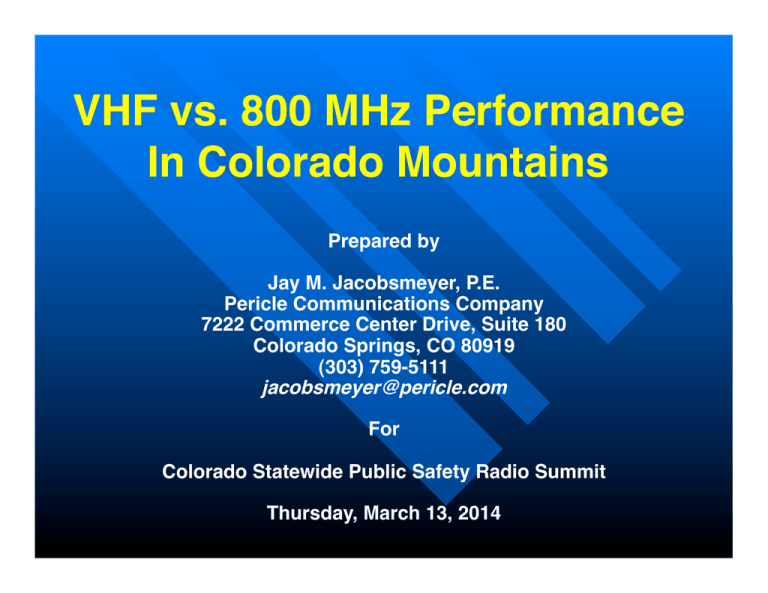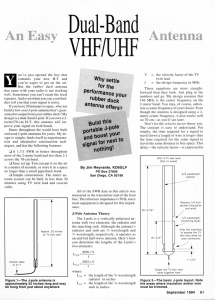VHF vs. 800 MHz Performance in Colorado Mountains
advertisement

Prepared by Jay M. Jacobsmeyer, P.E. Pericle Communications Company 7222 Commerce Center Drive, Suite 180 Colorado Springs, CO 80919 (303) 759-5111 jacobsmeyer@pericle.com For Colorado Statewide Public Safety Radio Summit Thursday, March 13, 2014 Many Rural Systems Still VHF Today Most New Systems are 700/800 MHz – More channels available – Interoperability with State of CO – Interoperability with urban systems Does VHF Have Advantages Over 700/800? Which Band Wins in the Real World? Radio Propagation Refresher System Components – VHF vs. 700/800 – Transmitters – Receivers – Transmission line, filters, combiners – Antennas Interference Case Studies Frequencies 35 - 54 MHz (Low Band VHF) 150 - 174 MHz (High Band VHF) 450 - 512 MHz (UHF) 746 - 806 MHz (700 MHz) 806 - 869 MHz (800 MHz) 4.9 GHz Airlink Standards – FM = the standard since 1940 – Digital P25 = present and future Free Space Loss Shadow Loss – Diffraction – Reflection – Foliage Attenuation Material Attenuation – Walls – Windows – Body loss (for portable radios) – Other man-made objects Pt Gt Gr λ Pr = (4π r)2 where Pt = Transmitter power Gt = Transmit antenna gain Gr = Receiver antenna gain λ = Radio carrier wavelength 2 r = Path distance (4π r) FSL = 2 λ 2 ⎛ r⎞ FSL = 21.98 + 20 log10 ⎜ ⎟ ⎝ λ⎠ r, λ in the sameunits c 300 λ= = f fMHz FSL is Proportional to Freq. Squared I.e., Additional Loss = 20log10(f2/f1) Examples – Double frequency = 6 dB more loss – 800 MHz vs. 150 MHz = 14.5 dB more loss » Or reduced range of factor of 5.3 Notes: 1. Simplified representation assuming only free space loss. 2. Actual coverage boundaries are irregular due to terrain effects. 3. Repeater site antenna gain is 3 dBd for 150 MHz, 6 dBd for 450 MHz, 9 dBd for 800 MHz. 4. Transmitter power and receiver sensitivity is the same for all. 5. Portable radio antenna gain is the same for all. Free Space Loss – VHF wins by 14.5 dB Diffraction Losses Favor VHF – Abundance of theory and measurements support it – VHF wins Attenuation Losses Also Favor VHF – I.e., construction materials, foliage – VHF wins Exceptions – Fresnel zone loss on line-of-sight paths – Apertures (windows) small relative to VHF wavelength Transmitter – VHF & 800 MHz transmit power is comparable (100 W) - TIE Receiver Sensitivity – VHF & 800 MHz receiver sensitivity is comparable (-118 dBm) - TIE Transmission Line – Line loss less for VHF, but not dramatic difference - TIE Filters & Combiners – System dependent, sometimes less for VHF - TIE Antennas – Can be significant differences, see next slide – Short answer: 700/800 wins Efficient Antennas Have Lengths Close to Wavelength – 150 MHz: Lamda/4 = 0.5 meters (1.6 feet) – 860 MHz: Lamda/4 = 0.1 meters (3.4 inches) Mobile (Vehicle) Radio – Quarter wavelength antennas are practical at 150 and 860 MHz Portable (Handheld) Radios – Quarter wavelength antennas not practical at 150 MHz – VHF gain will be typically be less than 700/800 MHz radio Repeater Site Antennas – Space limitations typically limit 150 MHz antennas to 6 dBd (omni) – Typical 700/800 MHz antennas gain = 9 dBd (omni) – Higher gain at 700/800 MHz , though possible, is not necessarily good at high sites VHF – Co-channel: Somewhat variable, FCC specifies minimum separation – Co-site: Highly variable, depends on quality of site and protections installed at repeater – No duplex band, so difficult to isolate transmit and receive – Lots of interference sources at VHF 700/800 MHz – Co-channel: Somewhat variable, FCC specifies minimum separation – Co-site: Highly variable, depends on quality of site and protections installed at repeater Bottom Line: – No theoretical difference, but VHF sites tend to be older and poorly maintained, resulting in greater vulnerability to interference – 700/800 MHz wins Three Cases – Larimer County, Middle Bald Mountain – Larimer County, South Bald Mountain – Gilpin County, Dakota Site Drive Measurements, Not Computer Models From Drive Test Data, – Mean difference favors VHF by 18.6 dB (mobile) – Mean difference favors VHF by 8.6 dB (portable) Coverage Comparison – Dakota site: 93% coverage above -99 dBm over drive test route – 800 MHz: Combination of Thorodin, Lookout, Dakota, Squaw, Black Hawk, and Mines = 92.6% above -105 dBm Mitigating Factor – If starting with clean slate, one would not necessarily choose these six sites to cover area of interest Path Losses in Rural Areas Favor VHF – E.g., in Gilpin County, mean difference > 18 dB Portable Antenna Favors 700/800 MHz – By roughly 10 dB Site Interference Could be Deciding Factor – But it might be correctable Replicating VHF Coverage with 800 MHz: – Can be expensive – But often other factors come into play – Frequency availability being the most important VHF vs. 800 MHz Decision Must Be Case by Case A logarithmic representation of a power ratio: Decibels = 10 log10(Pout/Pin) dB Properties: log (xy) = log(x) + log(y) log(x/y) = log(x) - log(y) log(xb) = b log (x) The ratio of two voltages in decibels: Decibels = 20 log10(Vout/Vin) dB Negative Decibels Means Ratio is Less Than 1 Positive Decibels Means Ratio is Greater Than 1 Decibels Are Unitless Decibels Relative to a Power Level are Useful, Too dBm = Decibels relative to 1 milliwatt dBW = Decibels relative to 1 Watt Other Decibels dBc = Decibels relative to power in the radio carrier dBi = Antenna gain relative to isotropic antenna dBd = Antenna gain relative to 1/2 wave dipole Why Use Decibels? – Engineers are lazy – Addition and subtraction easier than multiplication and division Some Useful Ratios to Remember Ratio Decibels 1 0 dB 2 3 dB 4 6 dB 5 7 dB 10 10 dB 20 13 dB 50 17 dB 100 20 dB 1,000 30 dB 10,000 40 dB 100,000 50 dB 1 million 60 dB


